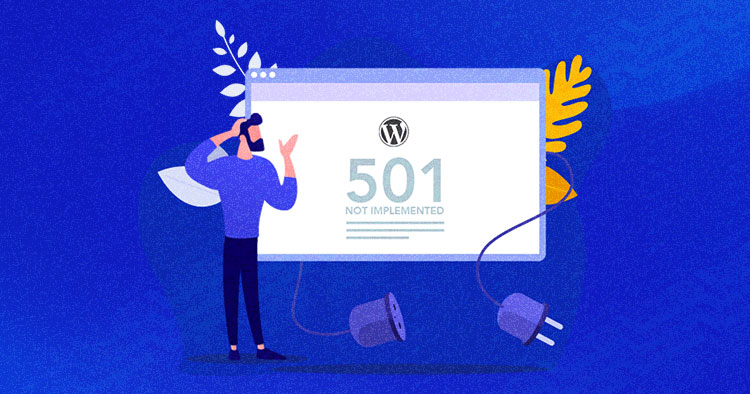In actuality, internet users do not frequently encounter the HTTP Error 501 status code. It is therefore likely to induce alarm when you encounter it, as it is not as common as a 404 or 301 code. The user has not done anything incorrect when they receive a 501 error, which is crucial to understand. Because it is totally server-based, the website hosting firm and admin team must pay attention to it.
What Is a HTTP Error 501?
The mistake will most likely be identified as a Not Implemented mistake when it is seen. This may be a little misleading to people because you aren’t asking something that is completely gone with a 410 error or something that is either not there or not reachable (as with a 404 error). The Not Implemented error indicates that the server does not have the functionality to process your request for the content; it is not a case of the content not being implemented. That’s the thing that hasn’t been done.
Therefore, it’s possible that the stuff you desire is there when you view it. You can’t access it, though, because something went wrong with the website’s back end. The server has rejected your get request actually can’t perform it.
Alternatively, and maybe more frequently, the unimplemented functionality is “being online.” Yes, visitors frequently see the HTTP 501 error when the website’s server is totally down and inaccessible. Because the server is legitimately unable to perform the requested function due to some sort of system failure, the hosting service will return a 501 error. A 500 error will typically be returned by a crashed server, but not always.
Remember that any time your server is unavailable (or some service is not available), it might negatively impact your search engine results. In this regard, Google is lenient; if your server produces a 501 (or 500) error, it will be noted for further investigation. That usually takes care of whatever went wrong. If not, Google can de-index and classify your website as offline or unavailable. Keeping an eye out for HTTP error 501 ought to be your top concern if you cherish your search engine rankings, which you obviously do.
One Small Thing
The reason you receive the 501 error is that the server should be able to process your request. You will receive a 405 Not Allowed error if the server administrators have intentionally disabled the server’s ability to process it. This indicates that they are purposely blocking that request even though nothing is incorrect. Feel free to get in touch with them, but know that it’s not a mistake that will prevent you from moving on.
What Can You Do About a 501 Error?
On the user’s end, you literally can’t fix the problem. In terms of rectifying the underlying cause and making the error go away for yourself or for others, you’re powerless. You can, however, try a few things to see if you can knock some sense back into the machines.
1. Reload The Page
The page can always be refreshed. When you see practically any form of problem on a website, you should (usually) take this action as soon as possible. In this manner, you can resubmit your request in the event that it was an error or a problem. To reload it if the refresh doesn’t work, try doing CTRL (or CMD) + SHIFT + R. By doing this, a hard reload will be carried out, avoiding any cached files that a normal reload would still employ.
2. Clear Your Browser Cache
The classic “have you turned it off and back on again?” question and clearing the cache in your browser are essentially the same thing. You can accomplish more than just avoiding it with a forceful refresh by clearing the cache in your browser. This method creates a blank slate for everything. Upon retrying, any files that were kept on your end that caused the server to fail to process your request and return a 501 are completely removed.
3. Check Your VPN and/or Proxy
There’s always a danger of mischief occurring when using a VPN or a proxy server to access the internet. To ensure that everything is in order, check your VPN settings. Verify that you are not receiving the same issues by visiting other websites. Try switching the locations of the servers. Use traceroute to confirm that the routed traffic is reaching the destination. Furthermore, cease utilizing a proxy server if you are.
For a while, disable it to check if those settings are preventing the server from completing the get request. There’s one more thing you may do if the 501 Not Implemented issue persists.
4. Reach Out
Finding the closest contact form is the neighborly and kind thing to do if you ever encounter the 501 Not Implemented error. If none of the aforementioned solutions work, contact the website owner. Chances are, they are unaware of the problem. They can then either get into the server themselves or get in touch with their host’s support who can.
What Causes a 501 Error?
Web administrators are aware that a server can crash and generate a 501 for a variety of reasons. Malware is one of the main offenders. Thus, the first task for any administrator is to ensure that the site is backed up and to do a virus scan to determine if anything untoward is happening behind the scenes. Ensure that you have Updraft Plus, WordFence, or Sucuri installed if you use WordPress. It is vitally crucial to take these security steps.
A 501 may occasionally be returned when a server experiences exceptionally high traffic. Perhaps a link from you reached a well-known Reddit forum, and as a result, traffic to your website dropped significantly. Maybe a DDoS attack is aimed at you. It’s possible that you ran an amazing offer that resulted in users attempting to reach your website at the same time and with unexpected success. The server may return an HTTP error 501 in response to any of these. The only way to fix server issues in many of these situations is to talk to your hosting provider about upgrading to more capable hardware or additional bandwidth. even if it’s just for a brief period of time during a single surge.
It gets us to the essence of a 501 error. Without root access to the server, it might be difficult for both users and administrators to determine the problem. There is only one thing left to try if a virus check returns negative results, emptying the caches, and restarting the system don’t work, and there isn’t a significant spike in traffic.
In the End, Contact Your Web Host
They actually hold the power in this circumstance. You do not have access to their data and metrics. In addition, the server hardware itself and its diagnostics and settings are frequently mentioned. The tech support teams will be able to address your issues whether you’re using another hosting platform or a managed host like Pressable or Flywheel. Certain mistakes, like 404, are rather simple to resolve. However, a 501 is not quite as easy as a 500. Therefore, if the fixes we listed above don’t work, give them a call or click the Contact Us button, and they’ll quickly get you back online.


2 Comments
I’m extremely impressed along with your writing abilities and also with the structure for your blog.
Is this a paid subject or did you customize it your self?
Anyway stay up the excellent quality writing, it is uncommon to see a great blog like this one these days.
Stan Store!
Thank you so much for your kind words! 😊 I truly appreciate your thoughtful feedback. The topic and structure of the blog are completely customized — I enjoy putting my personal touch on everything I create. It really means a lot to hear that you’re enjoying the content!